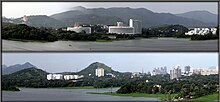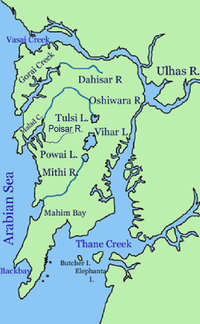Powai Lake
| Powai Lake | |
|---|---|
 | |
| Location | Mumbai, Maharashtra |
| Coordinates | 19°08′N 72°55′E / 19.13°N 72.91°E |
| Catchment area | 6.61 km2 (2.55 sq mi) |
| Basin countries | India |
| Max. depth | 12 m (39 ft) |
| Surface elevation | 58.5 m (191.93 ft) |
| Settlements | Powai |


Powai Lake (Pronunciation: [pəʋəiː]) is an artificial lake, situated in Mumbai, in the Powai valley, where a Powai village with a cluster of huts existed. The city suburb called Powai shares its name with the lake.

When it was built, the lake had an area of about 2.1 square kilometres (520 acres) and the depth varied from about 3 metres (9.8 ft) (at the periphery) to 12 metres (39 ft) at its deepest.[2]
The Powai Lake has gone through many stages of water quality degradation. The lake water which used to supply drinking water for Mumbai has been declared unfit to drink. The lake remains a tourist attraction.[3]
History
Before the lake was built by the
A stream tributary of the
After the drinking water supply objective was abandoned in the early 1890s, in view of poor quality of the water due to pollution,
MSAA is now involved with
- removal of water hyacinth infestation
- supporting research with Fisheries Department for conservation of the Indian mahaseer
- water quality analysis
- augmenting security.[2]
Access
The lake is about 40 kilometres (25 mi) from
Hydrology and water quality

It is reported that the average rainfall at Powai is about 2,540 millimetres (100 in), and the lake overflows for about sixty days each year. The overflow from the lake flows into the
Lake rejuvenation
Appreciating the problem of silting, growth of water hyacinth, weed, and eutrophication of the lake, the IIT Bombay's Class of 1980 launched a "Revitalization of Powai Lake" with the objective of restoring the lake to its original pristine and sustainable form by adopting Eco-friendly designs and materials for the restoration works.[11]
Some of the tasks proposed to be undertaken with the funds donated by IIT, Bombay included:
- Removing water hyacinth and weeds from the lake in parts nearest to the campus
- Starting a publicity and an awareness program in the area
- Building embankments, walkways and pathways to the lake
- Constructing a large gazebo for an evening (or morning or afternoon) by the lake
- Planting trees, and creating a garden
- Installing docks, deploying boats and canoes
- Allocating funds for annual maintenance
The project was proposed to be professionally managed with a project manager working under directives of IIT Bombay with an "Oversight Committee" to monitor objectives set for the restoration work.
In 1995, the National Lake Conservation Plan (NLCP) of the
Desilting project
The Lake's water depth is reported to have reduced to as little as 0.33 metres (1.1 ft) at some locations, on account of the large inflow of sewage, domestic waste water and silt from surrounding residential and industrial areas.[6]
Brihanmumbai Municipal Corporation (BMC) has therefore plans to desilt the Powai Lake at a cost of US$9 million.[12]
Fauna
Many crocodiles have been seen on the lake side.[13]
Flora
Powai Lake views
-
Powai Lake
-
Powai Lake - Before Heavy Showers of Rain
-
Powai Lake - After Heavy Showers of Rain
-
Powai lake in night. Picture take from JVLR side
References
- ^ "Powai lake". Archived from the original on 24 September 2014. Retrieved 30 August 2012.
- ^ a b c "History Of Powai Lake". Members.tripod.com. Retrieved 24 October 2013.
- ^ "Mumbai Hotels: Mumbai Tourist Attractions: Powai Lake". Bombay-mumbai-hotels.com. Retrieved 30 August 2012.
- ^ a b "Greater Bombay Places - Powai Lake". Maharashtra State Gazetteers. 1987. Retrieved 7 March 2012.
- ^ "Powai Lake One of the lakes supplying water to Mumbai". 19.126923;72.90287: Satellite-sightseer.com. Retrieved 30 August 2012.
{{cite web}}: CS1 maint: location (link) - ^ a b "A design for echo sustainability: lessons from a stressed environment in Mumbai" (PDF). Grassrootsresearch.org. Archived from the original (PDF) on 16 February 2012. Retrieved 30 August 2012.
- ^ "Powai Lake". Mumbainet.com. Archived from the original on 16 February 2012. Retrieved 30 August 2012.
- ^ "Hiranandani Gardens – 1 BHK and 2 BHK Flats / Apartments | Residential Project in Powai, Mumbai".
- ^ "Powai Lake: Information from Answers.com". Answers.com. Archived from the original on 28 August 2014. Retrieved 24 October 2013.
- ^ a b "Envis". Envis.maharashtra.gov. Archived from the original on 15 July 2011. Retrieved 30 August 2012.
- ^ [1] Archived 11 December 2007 at archive.today
- ^ [2] Archived 11 November 2010 at the Wayback Machine
- ^ [3] Archived 30 April 2013 at the Wayback Machine
- ^ "Monsoon Magic at IIT 17-08-2008". Flickr.com. Retrieved 30 August 2012.
- ^ [4] Archived 19 August 2008 at the Wayback Machine
External links
- Community Newspaper of Powai
- Powai Lake Satellite image in Google Maps
- Powai Temple Archived 16 July 2015 at the Wayback Machine
- All Info on powai categorized












